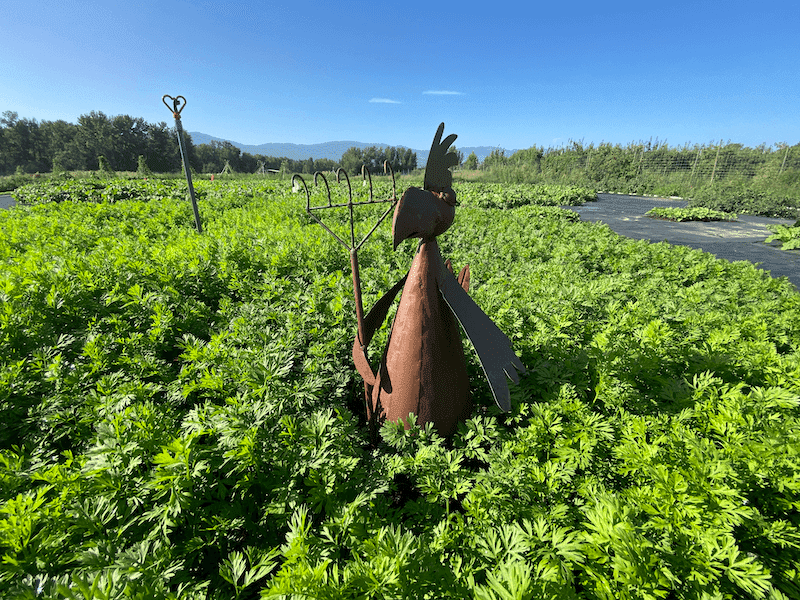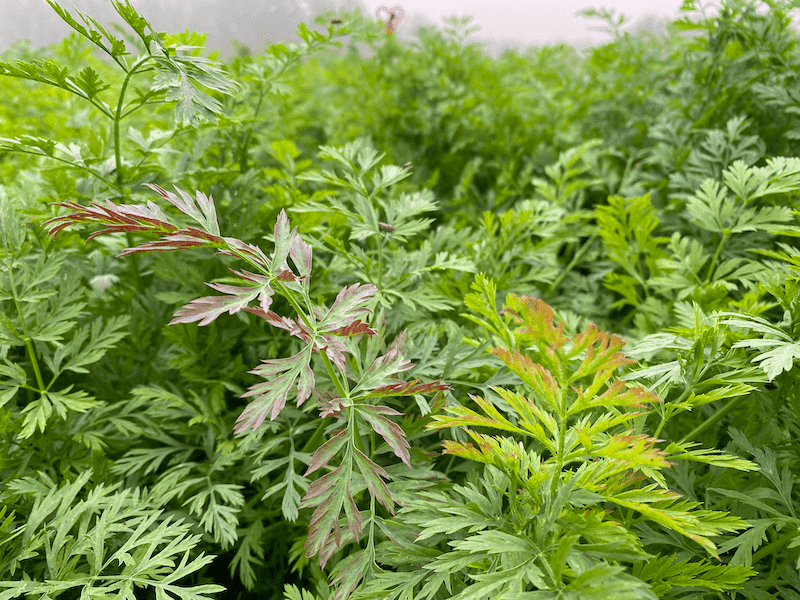
Carrots are the sixth most consumed vegetable in the United States behind tomatoes , peppers , corn , beans , and potatoes. They are a biennial crop, producing their taproot the first year, and, if left to grow, flower, set seed and die the second year. Although most all the carrots marketed in the United States today are orange, other colors such as red, yellow, or purple can occasionally be found in supermarkets and almost always in specialty markets such as Whole Foods. All carrots can be eaten root to tip, with the leaves often added to salads.
California leads the way growing carrots producing nearly two thirds of all carrots in the country. Washington State is second producing another 10 percent with the remainder produced by 35 other states cultivating less than 1,000 acres per state.
Carrots, a cool season crop, are always direct seeded. The carrot seeds planted at a seed rate of 8 ounces per cultivated row acre foot – an acre would require approximately 6,000 pounds of carrot seed to sow 60 cultivated rows spaced 3 feet apart.
Soil should be properly prepared to grow long, straight, sweet carrots and at a desired yield. Therefore, a prepared field must provide a loose, friable, deep, and well-drained for seeds to germinate and carrots to fully form without crooks, forks, and bends. This can be achieved by repeated deep plowing at least 16 inch deep followed by harrowing, leveling, and cleaning if necessary.
Roots attain optimal color when the air temperature is 60º to 70ºF. Although carrots are available throughout the year, carrots are typically available from local growers in season in the summer and fall when they are the freshest and most flavorful. Any other time of the year, carrots are shipped in from cooled warehouses where they have been stored.
As a rule, supermarket carrots have been mechanically grown, agriculturally machined from seed to harvest. Mechanized agriculture is unfortunately responsible for an irresponsible use of water for irrigation and overuse of artificial fertilizers and chemicals that pollute the environment.

Cultivated carrot production is not economically viable in close quarter growing environments common in urban farms and gardens where land size is typically less than an acre.
Crop Circle Farms ® has developed a circle shaped Carrot Grower that can grow long, straight carrots in challenging places and spaces, including rooftops, empty city lots, parking lots, community gardens, and urban food deserts.
Crop Circle Farms Carrot Growers are large, panelized containers that are filled with nutrient rich growth medium mixed with essential ingredients to grow carrots. The best soil for growing carrots has a pH around 6.5 and phosphate and potassium fertilizer promote better root development. Too much nitrogen will grow excessive hair up and down the root and too much phosphate will cause the roots to pale and lose color. An 8-12-16 nitrogen phosphate and potassium fertilizer is best for growing carrots.
Carrot Growers use just 20 feet of space to grow thousands of long, straight, sweet carrots. Carrots are elevated for easy plant and harvest and water with a below canopy curled soaker hose. Growing zones fortunate to have a 6-month growing season, two carrot harvests are possible, one in early summer and one in the late fall.

There are many different types of carrots to choose from, each with its unique flavor, texture, and color. Here are some popular options:
Ultimately, the best variety of garden carrot will depend on personal preferences, growing conditions and guesstimated market price.
When sowing carrots, seed density is vitally important; if seeds are spaced too far apart, then production per unit of space will be lower, if carrot seeds are too close together, then carrots struggle to grow and mature.
A Crop Circle Seed Dispenser is used to space carrot seeds at the proper distance; about 2 inches on center. It takes just 30 minutes to sow 20,000 carrot seeds by hand. A moveable ramp system that spans the grower is used to access the interior of the grower for seeding and weeding.
Once seeds are broadcast, they are covered with a half an inch of compost and watered using the elevated spray nozzle at the center of the grower. A garden hose connected to an external water supply provides irrigation.
The Crop Circle Carrot Grower is deep; about 20 inches to facilitate growing long root type carrot varieties like Imperator, however, it will grow any carrot variety including yellow, purple, white, and orange carrots, market Nantes carrots, English Chantenay carrots, commercial Danvers Carrots and Romeo carrots for salads.
Carrots are pulled in bunches by hand as the panels are disassembled. In most growing zones, a second harvest is possible the same season. A 15-foot carrot grower grows 20,000 carrots every 3 months depending on climate and variety.
For a second harvest, the panels are reassembled and filled with fertilized soil. At season's end, the Carrot Grower is disassembled, cleaned, and stored over winter. In the spring, it is reassembled, filled with soil, and planted with carrots.
An optional enclosure protects carrots from the elements and can be used like a mini greenhouse in the early spring to get to harvest quicker. An optional germination cloth may be used to germinate carrot seeds two weeks sooner, which is important for achieving more than one harvest the same season. Even in areas where two harvests are common, a third is entirely possible with a Crop Circle Farms Carrot Grower.
Ready to transform your land into a high-yield, sustainable farm? Let Crop Circle Farms design and build a custom, low-impact, and water-efficient farm tailored to your needs. Double your income and cut your costs in half! Contact Us
Help us expand our mission to revolutionize agriculture globally. We are seeking partners to implement Crop Circle Farms to feed people in need. Together, we can build scalable food production systems that save water, reduce costs, and feed thousands of people. Contact Growing To Give